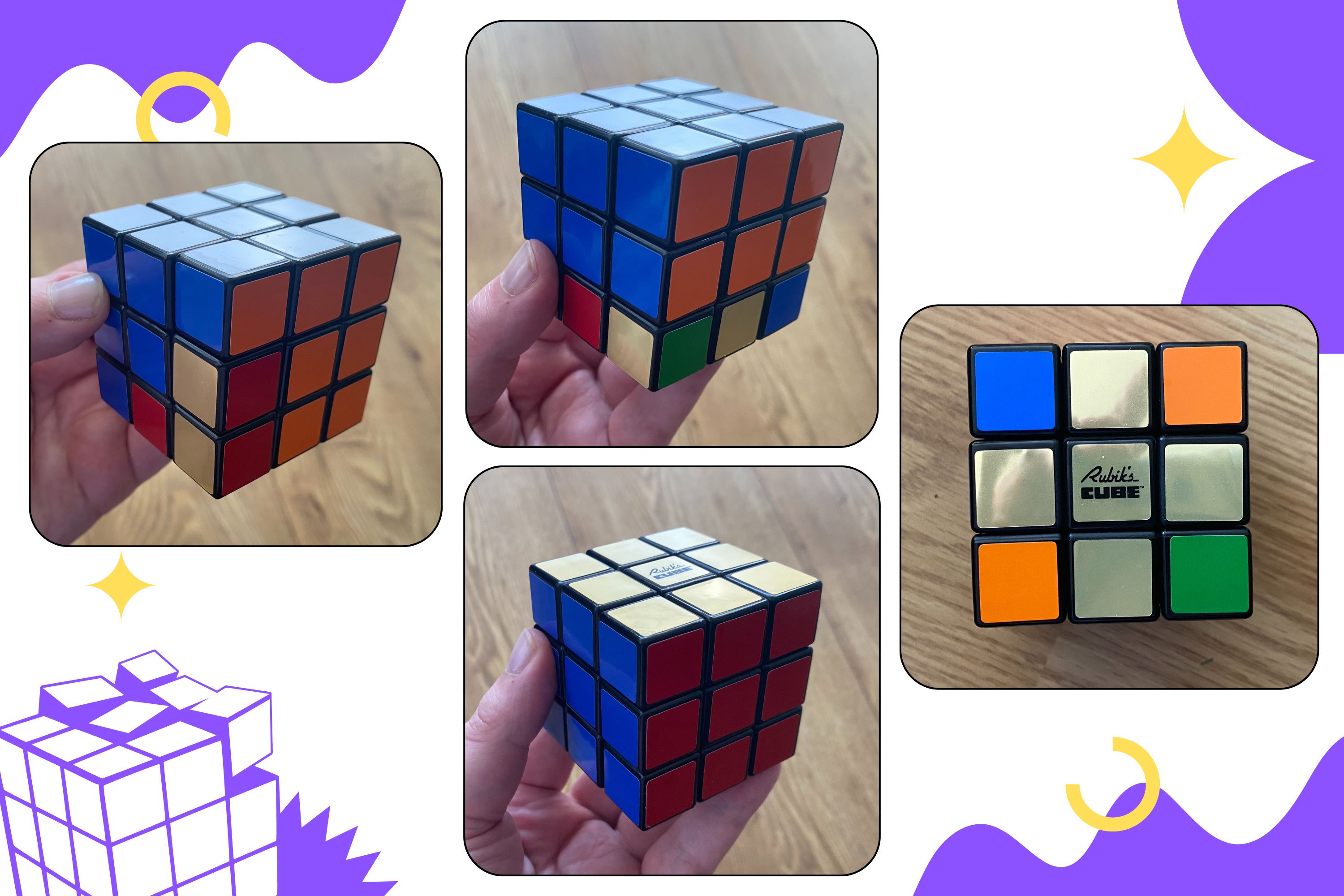
It's been 50 years since the Rubik's Cube first launched, and it's captivated audiences ever since. With a special 50th anniversary retro cube on the list of this year's top toys, the puzzle's popularity is still going strong. Suitable for children (and adults) aged eight and over, the Rubik's Cube is a brilliant option if you are concerned about screen time, and it's small and compact enough to make a perfect travel toy. And it was one of the most popular toys when millennials were kids, alongside Beanie Babies and Game Boys. Plus, it doesn't need batteries. Result!
Plus, it's super engaging. Before you even try it (or find a method to help you solve it), it feels like it should be relatively easy to solve, right? After all, it's small enough to fit into your hand, and it's suitable for kids (hello, dexterity and problem-solving skills), I mean, really, how hard can it be? Well, as 10 year old me discovered in a pre-internet era, it was flippin' hard - the original Rubik's Cube has 43,252,003,274,489,856,000 combinations (that's just over 43 quintillion for those like me, who just can't comprehend that many digits) and only one solution. And 10-year old me was stumped (and impatient).
Now I'm grown, I've seen loads of hacks online about the logic and process behind solving the puzzle, which makes me want to attempt the cube again. Now I've got access to the retro Rubik's Cube (and the internet), here's how I got on!
How to solve a Rubik's Cube
I tried four different methods and hacks to solve a Rubik's Cube with the hopes of approaching the puzzle with some kind of logical plan to lead me to success, rather than just aimlessly twisting and turning the sides in the hopes of magically making enough moves to go full circle and complete the brain teaser, which was definitely my approach when I was younger.
But the Lisa Simpson in me always baulked at not being able to solve it in one sitting, and that's trait has definitely not gone away as I've matured.
As well as completing it for myself, I also wanted to gauge just how easy it was to follow the hacks and methods and determine which I thought was the best method for children to follow.
Method #1 - Official Rubik's Cube Method
What is the method? First, I tried the official Rubik's method. This is similar to the seven step method mentioned below, in that it involves working in layers and beginning with the white face of the cube. But this method involves making a daisy shape on the top layer (like the white cross but with a yellow square in the middle of it instead of a white one). Then once you have solved the white layer, you go on to the middle layer, before completing the final layer.
Out of the methods I tried, this one is definitely the most handy for kids to follow as it has really clear and colourful diagrams for every step of the process. Again, this was a bit painstaking to follow, but it's definitely the case of the more you do it, the more it'll be committed to memory, and you'll eventually be able to do it without the instructions. That being said, this can be really positive for children, teaching them about perseverance and the importance of practise in order to become good at something. They can work towards the goal of being able to solve the cube without following the instructions, then once they can do that, they could start timing themselves to see if they can do it quicker than before.
Did I solve it? Yes
Difficulty rating: 7/10 (there are a lot of steps, but the diagrams are really clear and helpful)
Method #2 - the seven-step method
What is the method? Next up was to try the seven step method - this starts with creating a cross shape of white squares on the top of the cube, which is easy enough, but you have to make sure that you have two squares of matching colours following on from the cross as you move down the sides, which is harder than it looks. Then you have to get the white corners in place, then you work on the second layer, before you start on a yellow cross, change up the corners, give it a twist, and then, all being well, you've solved the cube.
This method was painstaking, but it worked, eventually. You have to make sure you orient the cube exactly as the instructions state, otherwise you inadvertently mess up layers you've already solved. Although it worked, this particular set of instructions seemed like they might be too complex for a child to follow, and there weren't many helpful images to follow along with.
Did I solve it? Yes
Difficulty rating: 6/10 (Children may need help from adults to decipher the instructions)
Method #3 - The Instagram Hack
What's the method? This hack states that if you repeat a sequence of four moves, six times, you can solve the cube. There is a really simple diagram to follow, and each move involves moving two columns either up or down, and the top and bottom layers either clockwise or anticlockwise.
I saw this method when I was scrolling Instagram, and immediately saved it to try later. With more than 350,000 likes, and a seemingly quick and easy method. How exciting, I thought, this will turn my cube into a lovely mindfulness activity that I can try when I need to shift my brain into a different gear for a few minutes, and it will be super easy for kids to follow. It involves repeating four specific moves, six times in order to solve the cube. But this hack only works if you start with a completed cube. If you have a jumbled cube, like I did, this gets you nowhere near to solving it.
Did I solve it? No
Difficulty rating: 1/10 (the moves are simple to follow, so it feels like it should be easy, but in the end, the process just doesn't solve a jumbled cube).
Method #4 - Using a Cube Solver
What's the method? If you have tried and tried to solve the cube, are desperate to solve the puzzle as quickly as possible, you can try a Rubik's Cube solver, like this one, where you input exactly what each of your cube's faces look like, and get personalised steps to solve it.
This might feel like a cop-out and you won't necessarily get the same sense of accomplishment than if you solve the puzzle using an alternative method, but it's not necessarily a bad solution, especially for a child.
Kids will need to input the coloured squares exactly as they appear on the faces of the cube, which can help them practice their spatial reasoning. Once they have their solution, they still have to follow instructions on the screen in order to solve the puzzle. Using a tool like this can help children improve their dexterity and handling of the cube, and get used to how the puzzle moves, and how certain movements result in particular outcomes. This can help them grow more confident in trying new sequences of moves when they play again, with the aim of solving it themselves.
Did I solve it? Yes
Difficulty rating - 2/10
Best way to solve a Rubik's Cube - our verdict
Firstly, the best way to solve a Rubik's Cube for the first time is definitely to follow instructions. You need a method to follow, otherwise you just end creating more of a jumble to solve.
A childhood dream realised! I solved my first Rubik's Cube!
My favourite method was the official Rubik's Cube solution - there are clear and easy to follow diagrams for every step of the process - which makes it much easier for children to follow along with. It's a slow process to begin with though, but as you become more comfortable with the moves you can make, and the logical steps to follow, you'll definitely get quicker.
The seven step method is very similar - in fact lots of the methods you find online are very similar to the official solution, and there are also videos you can follow if you want to see a real-life solve - we've added links to our favourites below.
I wouldn't knock Cube Solvers either, especially if you feel like you've got into a pickle and want to start again. But I'd steer clear of any method that seems too quick or too simple - it's probably also too good to be true.
- Official Rubik's Cube Solution
- Ruwix Seven Step Guide
- Wikihow
- Teach Kids Engineering Method
- VIDEO: How to solve a Rubik's Cube with Matty Hiroto Inaba, ranked 6th in the WCA (World Cube Association)
How long does it take to solve a Rubik's Cube?
How long to it takes to solve a Rubik's Cube will depend on which method you use to solve it, and how many times you've attempted the method. Once you know the process for solving a Rubik's Cube, you could potentially solve the puzzle quite quickly, and without the need for instructions. But it'll take a lot of practice to beat the current world record which is a jaw-dropping 3.12 seconds.
Tips for solving a Rubik's Cube
- Keep the Rubik's Cube on a table so you can keep the front face consistent as you go through your sequence of moves
- Try to work in layers
- Centre pieces are always in the centre - they don't move position
- Get used to the jargon - the letters F R U L D, stand for Front, Right, Up, Left, Down. The letters on their own, in any method, mean to move that face 90 degrees clockwise. If those letters are followed by and apostrophe, such as F', that means the move should be made anticlockwise. If the letter is followed by the number two, such as F2, that means the move is 180 degrees rather than 90.
Want to have a go at the Rubik's Cube?
With it's 3x3 squares and quintillions of combinations, the original Rubik's Cube is perfect for puzzle perfectionists looking for something to challenge them. It's small, silent, screen-free and encourages independent play.
For a bigger, bolder version of the classic, you have the Master Cube which has 16 squares on each face, rather than nine. But those seven extra squares mean even more possible combinations - 7.4 septilliards to be exact, compared to the 43 quintillion possible combos on the original cube. Not for the faint hearted, but mega fun!
For a budding puzzle cube solver, this trio of puzzles is a great shout. The set includes three puzzles - a 3x3 cube, a 2x2 cube and a pyramid. The 2x2 cube encourages speed, while the pyramid cube offers a new challenge to those who may have already mastered the traditional 3x3 cube. All are small enough for on-the-go fun.
For more screen-free options, check out our picks of the the best slime toys for messy sensory play, or the most popular Tonies for some chilled storytime. If you're looking for a buget gift, we've rounded up the best toys under £10.







